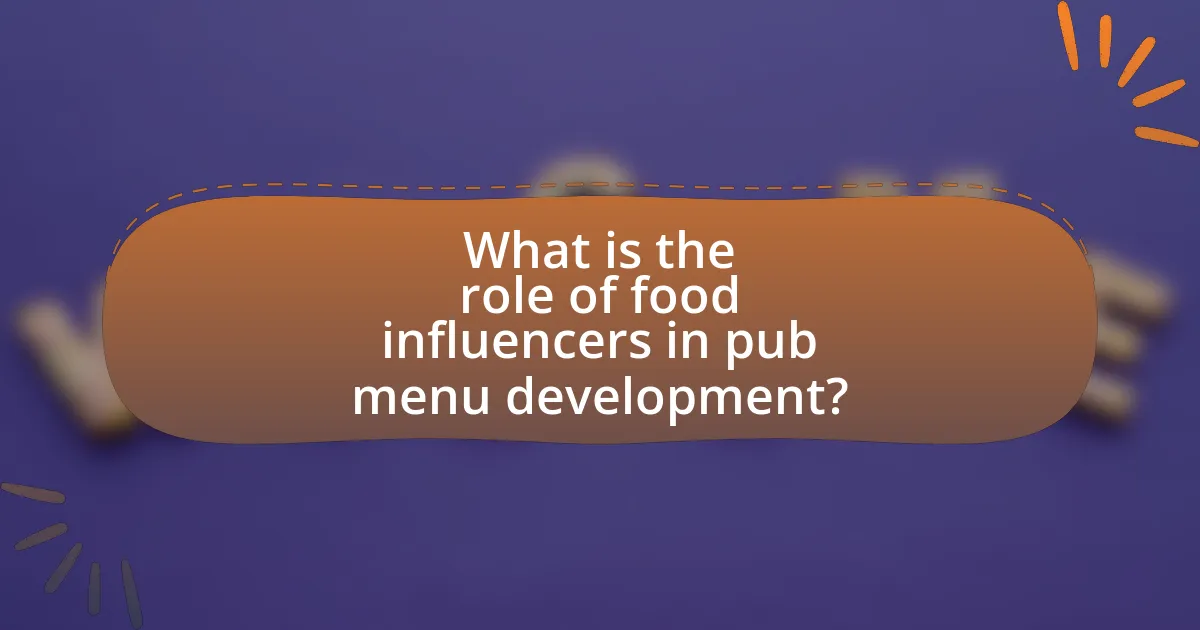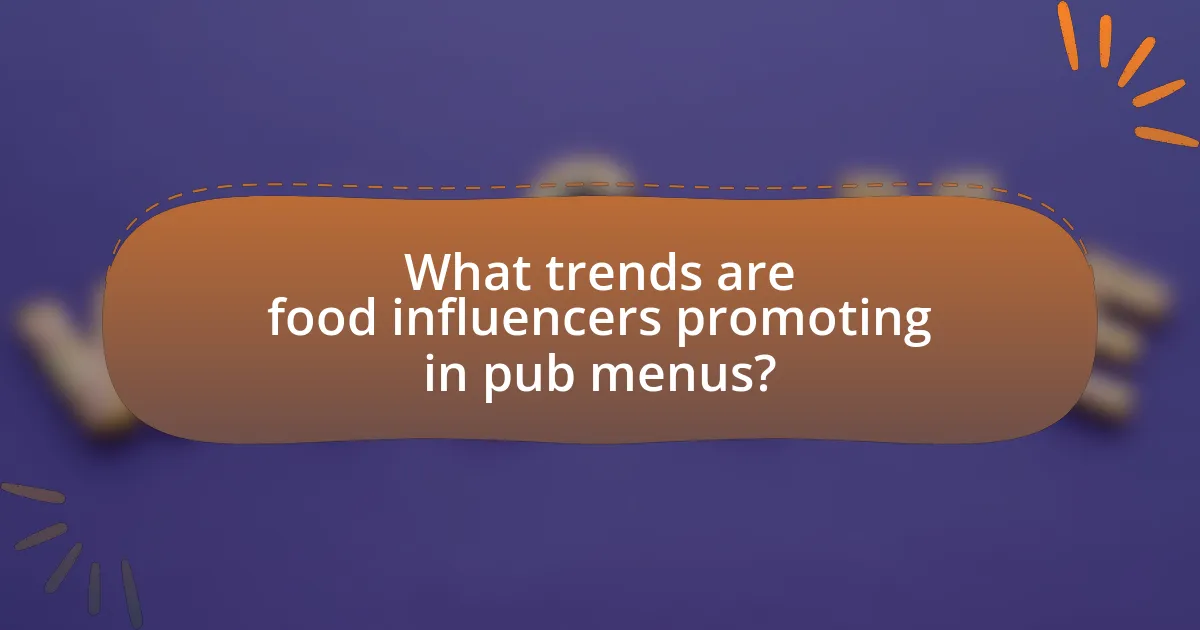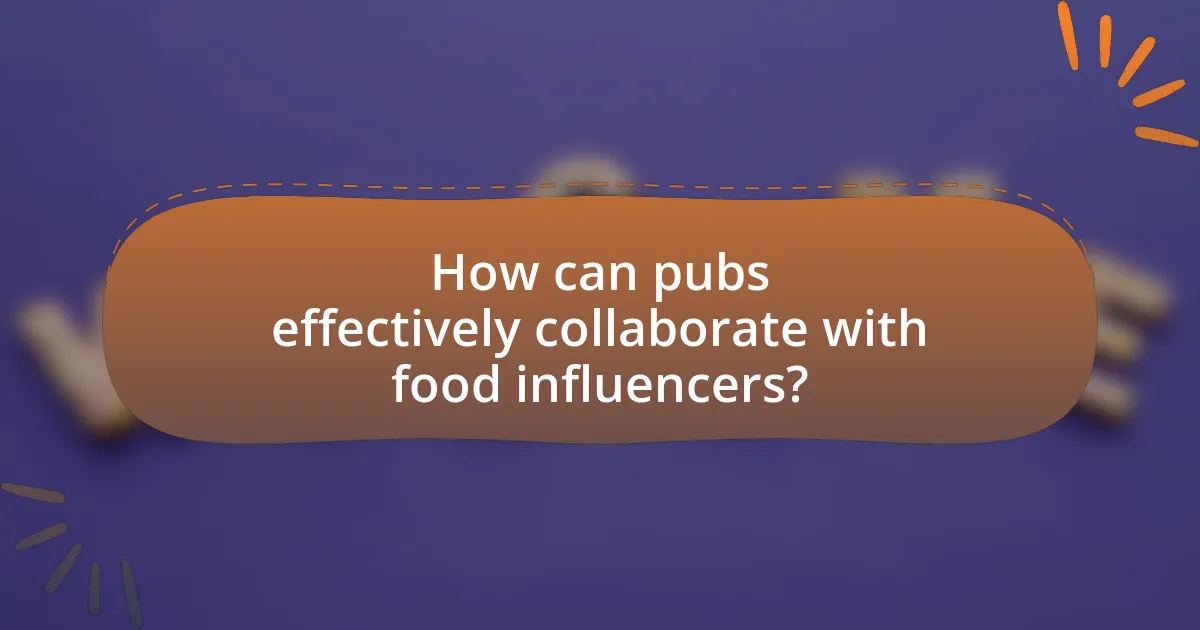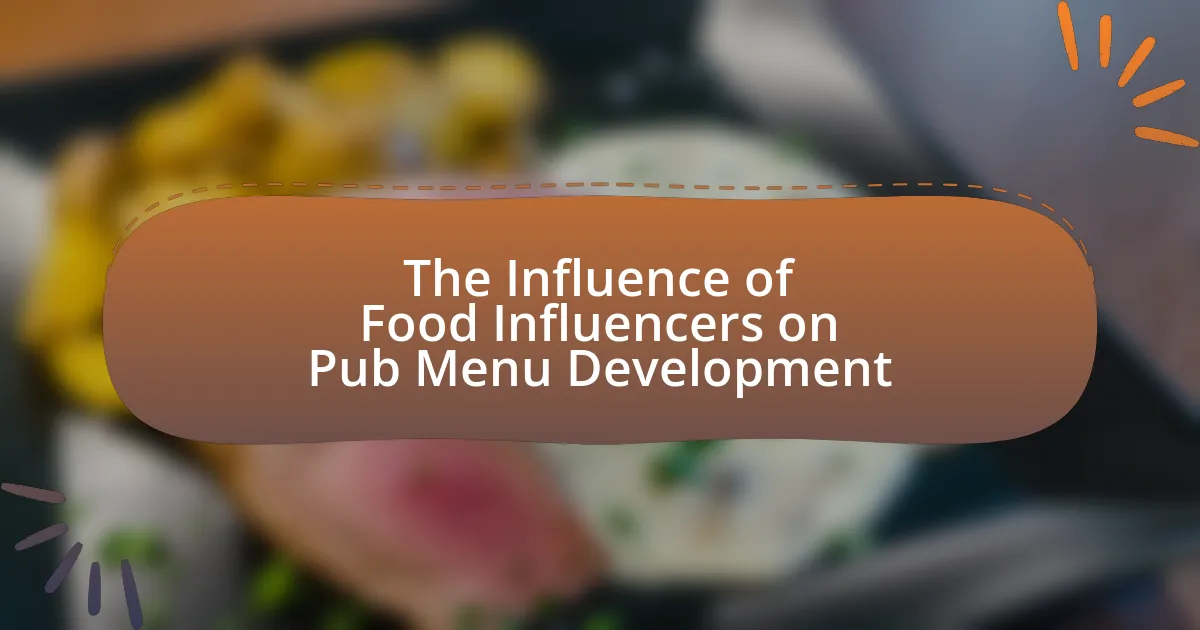Food influencers play a crucial role in the development of pub menus by shaping consumer preferences and trends through their social media presence. Their ability to create visually appealing content and engage audiences significantly impacts dining choices, with studies indicating that a substantial percentage of consumers rely on influencer recommendations when deciding where to eat. The article explores how food influencers affect menu development by promoting trends such as plant-based options and gourmet comfort food, while also emphasizing the importance of aesthetics in food presentation. Additionally, it discusses strategies for effective collaboration between pubs and food influencers, highlighting the benefits of aligning brand values and integrating influencer feedback into menu offerings.

What is the role of food influencers in pub menu development?
Food influencers play a significant role in pub menu development by shaping consumer preferences and trends through their online presence. They leverage social media platforms to showcase food items, creating buzz and driving demand for specific dishes. For instance, a study by the NPD Group found that 30% of consumers are influenced by social media when deciding what to eat, highlighting the impact of food influencers on dining choices. Additionally, their feedback can guide pubs in curating menus that resonate with target audiences, ensuring that offerings align with current culinary trends and consumer interests.
How do food influencers impact consumer preferences?
Food influencers significantly impact consumer preferences by shaping perceptions of food trends and dining experiences. Their curated content, often showcasing visually appealing dishes and unique culinary experiences, drives engagement and interest among followers. Research indicates that 70% of consumers are influenced by social media when making dining decisions, highlighting the power of food influencers in guiding consumer choices. Additionally, food influencers often collaborate with brands, creating a sense of authenticity and trust that further sways consumer preferences towards specific products or dining establishments.
What strategies do food influencers use to shape tastes?
Food influencers shape tastes primarily through visually appealing content, storytelling, and trendsetting. They create engaging images and videos that highlight food aesthetics, making dishes more desirable. By sharing personal narratives and experiences related to food, they connect emotionally with their audience, fostering a sense of authenticity and relatability. Additionally, food influencers often identify and promote emerging food trends, influencing consumer preferences and dining choices. For instance, the rise of plant-based diets has been significantly propelled by influencers showcasing innovative vegan recipes, which has led to increased demand for such options in restaurants and pubs.
How do social media platforms amplify their influence?
Social media platforms amplify their influence by leveraging algorithms that prioritize engaging content, thereby increasing visibility and reach. These algorithms analyze user interactions, such as likes, shares, and comments, to promote posts that resonate with audiences, leading to viral trends. For instance, platforms like Instagram and TikTok utilize visual content and short videos, which are more likely to capture attention and encourage sharing, thus enhancing the influence of food influencers on trends and menu development in pubs. Additionally, the ability to target specific demographics through advertising allows brands to reach potential customers effectively, further solidifying the platforms’ impact on consumer behavior.
Why are food influencers important for pubs?
Food influencers are important for pubs because they significantly enhance visibility and attract customers through social media platforms. Their ability to showcase food and drink offerings visually engages potential patrons, leading to increased foot traffic and sales. For instance, a study by the Digital Marketing Institute found that 49% of consumers rely on influencer recommendations when making dining decisions. This demonstrates that food influencers can effectively shape public perception and drive interest in a pub’s menu, ultimately influencing menu development to align with trending tastes and preferences.
What benefits do pubs gain from collaborating with food influencers?
Pubs gain increased visibility and customer engagement by collaborating with food influencers. This partnership allows pubs to reach a broader audience through the influencer’s established follower base, which can lead to higher foot traffic and sales. For instance, a study by the Digital Marketing Institute found that 49% of consumers depend on influencer recommendations when making food choices. Additionally, food influencers can provide authentic content that showcases the pub’s menu, enhancing its appeal and credibility. This strategy not only boosts brand awareness but also fosters a community around the pub, encouraging repeat visits and customer loyalty.
How do food influencers enhance a pub’s brand image?
Food influencers enhance a pub’s brand image by creating visually appealing content that showcases the pub’s offerings, thereby attracting a wider audience. Their large followings on social media platforms enable them to reach potential customers who may not have been aware of the pub, increasing visibility and engagement. For instance, a study by the Digital Marketing Institute found that 49% of consumers depend on influencer recommendations when making purchasing decisions, highlighting the effectiveness of influencers in shaping public perception. Additionally, food influencers often share authentic reviews and experiences, which can build trust and credibility for the pub, further solidifying its brand image in the competitive food and beverage market.

What trends are food influencers promoting in pub menus?
Food influencers are promoting trends in pub menus that emphasize plant-based options, gourmet comfort food, and locally sourced ingredients. These trends reflect a growing consumer demand for healthier, sustainable, and high-quality dining experiences. For instance, a survey by the National Restaurant Association found that 60% of consumers are more likely to visit a restaurant that offers plant-based dishes, indicating a significant shift towards vegetarian and vegan options in pub menus. Additionally, food influencers often highlight unique flavor combinations and artisanal preparations, which enhance the appeal of traditional pub fare, making it more innovative and appealing to a broader audience.
How are health-conscious options influencing menu choices?
Health-conscious options are significantly influencing menu choices by driving restaurants to incorporate healthier ingredients and alternatives. As consumer demand for nutritious meals increases, establishments are adapting their menus to include items such as plant-based proteins, whole grains, and lower-calorie options. Research from the National Restaurant Association indicates that 70% of consumers are more likely to choose a restaurant that offers healthy menu options, demonstrating a clear market trend towards health-oriented dining. This shift not only caters to the preferences of health-conscious diners but also aligns with broader public health initiatives aimed at reducing obesity and chronic diseases.
What specific health trends are being adopted by pubs?
Pubs are adopting specific health trends such as offering plant-based menu options, low-calorie alcoholic beverages, and gluten-free choices. These trends reflect a growing consumer demand for healthier dining alternatives and align with the increasing popularity of plant-based diets, which saw a 300% increase in the number of people identifying as vegan in the UK from 2014 to 2019. Additionally, the market for low-alcohol and alcohol-free drinks has expanded significantly, with sales of non-alcoholic beer rising by 30% in 2020 alone. This shift in menu offerings demonstrates pubs’ responsiveness to health-conscious consumers and their desire for inclusive dining experiences.
How do food influencers advocate for sustainable ingredients?
Food influencers advocate for sustainable ingredients by promoting local sourcing, highlighting eco-friendly practices, and educating their audience about the benefits of sustainable food choices. They often showcase recipes that utilize seasonal produce and emphasize the importance of reducing carbon footprints associated with food production. For instance, studies indicate that local food systems can reduce greenhouse gas emissions by up to 25% compared to conventional food supply chains. Additionally, influencers frequently collaborate with brands that prioritize sustainability, thereby increasing consumer awareness and encouraging responsible purchasing behaviors.
What role does visual presentation play in menu development?
Visual presentation plays a crucial role in menu development by significantly influencing customer perception and decision-making. Research indicates that visually appealing menus can enhance the dining experience, leading to increased customer satisfaction and higher sales. For instance, a study published in the Journal of Foodservice Business Research found that menus with high-quality images and attractive layouts can boost the perceived value of dishes, encouraging customers to order more expensive items. This demonstrates that effective visual presentation not only captures attention but also drives purchasing behavior, making it an essential component of successful menu development in the context of food influencers and pub dining.
How do food influencers emphasize the importance of aesthetics?
Food influencers emphasize the importance of aesthetics by showcasing visually appealing food presentations in their content. They utilize high-quality photography, vibrant colors, and creative plating techniques to attract viewers’ attention and enhance the perceived value of the dishes. Research indicates that visually appealing food can significantly influence consumer choices, as studies show that people are more likely to engage with and share images of aesthetically pleasing meals on social media platforms. This focus on aesthetics not only drives engagement but also encourages restaurants and pubs to prioritize visual presentation in their menu development to align with consumer preferences.
What are the best practices for visually appealing dishes?
The best practices for visually appealing dishes include using vibrant colors, thoughtful plating, and incorporating various textures. Vibrant colors attract attention and stimulate appetite; for example, contrasting colors like green herbs against a white plate enhance visual appeal. Thoughtful plating involves arranging food in a way that highlights its features, such as stacking or fanning ingredients, which creates depth and interest. Incorporating various textures, such as crispy, creamy, and crunchy elements, adds dimension to the dish, making it more engaging. Research indicates that visually appealing food can enhance the dining experience and increase customer satisfaction, as evidenced by studies showing that presentation significantly influences perceived taste and enjoyment.

How can pubs effectively collaborate with food influencers?
Pubs can effectively collaborate with food influencers by establishing mutually beneficial partnerships that leverage the influencer’s reach and expertise in food trends. This collaboration can involve inviting influencers to exclusive tasting events, where they can sample new menu items and provide feedback, thereby generating authentic content for their followers. Additionally, pubs can offer influencers incentives such as complimentary meals or promotional codes for their audience, which can drive traffic to the pub. Research indicates that 49% of consumers depend on influencer recommendations for their purchasing decisions, highlighting the potential impact of these collaborations on customer engagement and sales. By aligning their brand with influencers who resonate with their target audience, pubs can enhance their visibility and credibility in the competitive food and beverage market.
What strategies should pubs use to engage food influencers?
Pubs should leverage personalized outreach, exclusive tasting events, and social media collaborations to engage food influencers effectively. Personalized outreach involves directly contacting influencers with tailored messages that highlight the unique aspects of the pub’s offerings, which fosters a sense of connection. Exclusive tasting events allow influencers to experience new menu items firsthand, creating authentic content opportunities. Additionally, social media collaborations, such as sponsored posts or takeovers, can amplify the pub’s reach and enhance visibility among the influencer’s audience. These strategies are supported by the fact that 70% of consumers are influenced by the recommendations of their peers, including influencers, when making dining decisions.
How can pubs identify the right influencers for their brand?
Pubs can identify the right influencers for their brand by analyzing the influencer’s audience demographics, engagement rates, and content relevance to the pub’s offerings. This approach ensures that the selected influencers resonate with the target customer base, which is crucial for effective marketing. For instance, a study by the Digital Marketing Institute found that 49% of consumers depend on influencer recommendations, highlighting the importance of aligning with influencers who have a genuine connection to the pub’s theme and menu. Additionally, tools like social media analytics can provide insights into an influencer’s reach and impact, allowing pubs to make data-driven decisions in their influencer partnerships.
What are the key elements of a successful influencer partnership?
The key elements of a successful influencer partnership include alignment of values, clear communication, and measurable goals. Alignment of values ensures that both the brand and the influencer share similar beliefs and target audiences, which enhances authenticity and trust. Clear communication facilitates understanding of expectations, deliverables, and timelines, reducing the risk of misunderstandings. Measurable goals allow both parties to assess the effectiveness of the partnership through specific metrics, such as engagement rates or sales conversions. Research indicates that partnerships with these elements lead to higher engagement and better overall performance in marketing campaigns.
What common pitfalls should pubs avoid when working with food influencers?
Pubs should avoid misalignment of brand values when working with food influencers. This misalignment can lead to a disconnect between the pub’s identity and the influencer’s audience, resulting in ineffective marketing. For instance, if a pub known for traditional cuisine collaborates with an influencer focused on vegan food, the partnership may confuse potential customers and dilute the pub’s brand message. Additionally, pubs should steer clear of vague agreements regarding deliverables, as this can lead to unmet expectations and dissatisfaction on both sides. Clear communication about content requirements and timelines is essential to ensure a successful collaboration. Lastly, neglecting to engage with the influencer’s audience can diminish the impact of the partnership; actively responding to comments and fostering community engagement enhances visibility and credibility.
How can misalignment with influencers affect a pub’s reputation?
Misalignment with influencers can significantly damage a pub’s reputation by creating a disconnect between the pub’s brand image and the expectations of its target audience. When influencers promote a pub that does not align with their values or audience preferences, it can lead to negative perceptions among potential customers. For instance, if a pub known for upscale dining collaborates with an influencer who primarily promotes fast food, this inconsistency can confuse consumers and diminish trust in the pub’s brand. Research indicates that 60% of consumers are less likely to trust a brand that partners with influencers who do not resonate with their values (Source: Influencer Marketing Hub, 2021). This misalignment can result in decreased customer loyalty and a tarnished public image, ultimately affecting the pub’s overall success.
What are the risks of over-reliance on influencer marketing?
Over-reliance on influencer marketing poses several risks, including diminished brand authenticity, potential backlash from audiences, and fluctuating influencer credibility. Brands may lose their unique voice and authenticity if they depend too heavily on influencers, as consumers often seek genuine connections with brands. Additionally, if an influencer faces controversy or fails to resonate with their audience, it can lead to negative perceptions of the brand they represent. Research indicates that 63% of consumers believe that influencer marketing can be misleading, highlighting the risk of audience skepticism. Furthermore, influencer popularity can be transient; a decline in their relevance can adversely affect the brand’s visibility and engagement.
What are the best practices for integrating influencer feedback into menu development?
The best practices for integrating influencer feedback into menu development include actively engaging with influencers during the concept phase, utilizing their insights to align menu items with current trends, and conducting taste tests to gather direct feedback. Engaging influencers early allows for the incorporation of their audience’s preferences, ensuring the menu resonates with target customers. Utilizing insights from influencers can help identify trending flavors and dietary preferences, which are crucial for menu relevance. Conducting taste tests with influencers provides valuable real-time feedback, enabling adjustments before finalizing the menu. These practices are supported by studies showing that menus reflecting current trends and consumer preferences lead to increased customer satisfaction and sales.
